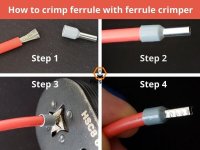Martinjmpr
Wiffleball Batter
How are most of you connecting your Anderson connectors? Crimp or solder?
I'm getting ready to make some cables with large (50A) anderson connectors.
Reason I ask is that I thought I was fairly decent at crimping but I've never been able to solder anything that didn't end up looking like a hot mess.
My previous attempt was OK for a couple of years but then it appears that the cable somehow worked its way out of the crimped connector and I lost the ability to charge my power box. So either my crimping failed or something else happened, not sure what.
Since I was on a camping trip I just ended up cutting the Anderson connector off, stripping the wire and wrapping it around the post on the battery. That was enough to get me home, and then once I got home I just put ring terminals on the cable and now I connect them directly to the battery posts with ring terminals. It's not as quick as an Anderson but it won't ever come off. either.
But I really do want to be able to make cables that won't fail on me. Is there some secret I'm missing?
I'm getting ready to make some cables with large (50A) anderson connectors.
Reason I ask is that I thought I was fairly decent at crimping but I've never been able to solder anything that didn't end up looking like a hot mess.
My previous attempt was OK for a couple of years but then it appears that the cable somehow worked its way out of the crimped connector and I lost the ability to charge my power box. So either my crimping failed or something else happened, not sure what.
Since I was on a camping trip I just ended up cutting the Anderson connector off, stripping the wire and wrapping it around the post on the battery. That was enough to get me home, and then once I got home I just put ring terminals on the cable and now I connect them directly to the battery posts with ring terminals. It's not as quick as an Anderson but it won't ever come off. either.
But I really do want to be able to make cables that won't fail on me. Is there some secret I'm missing?


